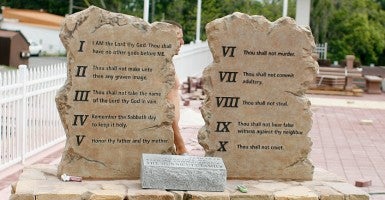By a margin of 7-2, the Oklahoma Supreme Court ruled on Tuesday to remove the state Capitol’s Ten Commandments monument. The state Supreme Court ruled that the monument is “obviously religious in nature and … an integral part of the Jewish and Christian faiths,” and therefore defies separation of church and state.
Attorney General Scott Pruitt said the monument was constitutional and cited a similar monument in Texas the U.S. Supreme Court deemed constitutional.
“Quite simply, the Oklahoma Supreme Court got it wrong,” Pruitt said in a statement. “The court completely ignored the profound historical impact of the Ten Commandments on the foundation of Western Law.”
As a result, Pruitt said his office will request a rehearing and attempt to repeal the verdict.
The case was originally filed by four plaintiffs from the American Civil Liberties Union (ACLU) of Oklahoma on the basis that the monument violates the Oklahoma State Constitution, which prohibits public funding or property to go toward supporting a particular sect of religion.
“I think that at the end of the day it is the right decision simply because it acknowledges limits on the government’s power to effectively decide what religious edicts are right and wrong,” said Brady Henderson, legal director for the ACLU of Oklahoma.
The ruling has received pushback from state officials, including Oklahoma Gov. Mary Fallin.
“Gov. Fallin is disappointed with the court’s opinion that a privately funded monument acknowledging the historical importance of the Ten Commandments is not allowed on Capitol grounds,” said Fallin’s spokesman Alex Weintz. “She will consult with the attorney general to evaluate the state’s legal options moving forward.”
Previous attempts have been made to remove the monument as well. Last March, American Atheists attempted to file a suit to abolish the monument. However, the case was rejected because the court found the plaintiffs did “not have standing to bring the legal action.”
Additionally, other individuals and groups have requested to install their own monuments next to the Capitol. Among these are a Hindu leader from Nevada, an animal rights group and a group who wished to institute a statue of Satan.
The monument was just reinstalled earlier this year in January, after it had been destroyed by 29-year-old Michael Tate Reed, who crashed his vehicle into the monument. Reed was released from a mental wellness facility the day the monument was reinstalled. Reinstallation efforts were derived solely from private funding.
The monument was constructed in 2012 with private funds from Rep. Mike Ritze’s family. Ritze was behind the legislation to approve the monument.




























